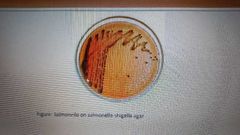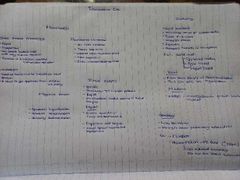![]()
![]()
![]()
Use LEFT and RIGHT arrow keys to navigate between flashcards;
Use UP and DOWN arrow keys to flip the card;
H to show hint;
A reads text to speech;
76 Cards in this Set
- Front
- Back
- 3rd side (hint)
|
FEATURES OF GRAM NEGATIVE BACTERIA |
• Gram negative bacilli • Either motile or non motile • Grow both aerobically and anaerobically |
|
|
|
Test identifies gram negative bacteria? |
• Oxidase negative ( No purple colour) • Catalase positive ( Bubbles formation) • Reduces nitrates to nitrites (Brick red precipitation) • Fermant glucose in peptone with production of either acid or acid and gas |
|
|
|
Escherichia Coli morphology |
• Gram negative • Non sporing • Usually motile • Fimbriae present in the most of the strains |
|
|
|
Escherichia Coli Cultural characteristics |
• Can draw easily on ordinary culture media • Does not have complex nutritional requirements • 37° C is the optimal temperature • Grows equally well under both aerobic and anaerobic conditions • Colony size is 1-1.5 mm i diameter • smooth, circular, glossy, and translucent |
|
|
|
Lab dx of E.coli |
●Direct inspection of the organism from the sample ●E.coli can grow well on the ordinary media ● Typical colonies are seen on ordinary media ● Biochemical test shall confirm the identity of E. Coli |
|
|
|
Neonatal tetanus |
2 doses of tetanus toxoid 6 weeks apart after 12th week of gestation 1 dose of tetanus toxoid for subsequent pregnancy upto 4th pregnancy |
|
|
|
Streptococcal sore throat |
Streptococcus pyogenes Causes acute tonsilitis |
|
|
|
Streptococcal sore throat complications |
Scarlet fever Rhematic fever Rhematic heart disease |
|
|
|
Categories of E.coli causing diarrhoea |
● Enteroheamorrhagic strains ● Enterotoxigenic strains ●Enteroinvasive strains ● Enteropathogenic strains |
|
|
|
Diptheria |
● Grayish membran in the throat ● Culture on blood tellurite agar - black colonies ● positive Elek test ● Growth on Loeffler agar |
|
|
|
Otitis media |
Streptococcus pneumoniae Haemophilus pneumoniae Streptococcus pyogenes
Culture - blood agar Lavage spcimens from sinuses |
|
|
|
Vincent's angina |
Borelia vincenti Gram staining |
|
|
|
Laryngitis and epiglottis |
Para. Influenza virus H. Influenzae Blood agar culture Chocolate agar |
|
|
|
Epidemic |
Infectious disease spreads rapidly to many ppl |
|
|
|
Outbreak |
Sudden rise in the number of cases of a disease |
|
|
|
Escherichia Coli antigenic structure |
Serotyping based on three types of antigen • O antigen ( cell wall lipopolysaccharide) • H antigen (Flagella protein) • K antigen ( Capsular polysaccharide /envelope |
|
|
|
Streptococcal sore throat labs |
Specimen- Throat swab Gram staining Grouping with test kits Serology-antibody to streptosin O |
|
|
|
Antibiotics resistance |
-abts becoming less resistant to the pathogen cuz of overuse, misuse -MRSA -Clostridium difficile |
|
|
|
Congenital Rubella |
● Rubella virus -Congenital Cataract -Congenital heart disease -CNS abnormalities -premature still birth • Virus spread via blood to the placenta Spreads to the fetus |
|
|
|
Congenital cytomegaly virus Labs dx |
Cytomegaly virus
○ Lab Dx- viral isolation from - throat wash -Urine in the first 2-3 weeks -Cytomegaly specific IgM in serum of neonate |
|
|
|
Congenital Syphilis |
Traponema pallidum -spirochete |
|
|
|
Rubella DX and treatment |
□ Labs Dx- Rubella specific IgM ○ Rubella vaccine ○ MR given to both sexes at the age of 3 years ○ Booster dose at 12-13 years ○Mop up vaccination for unimmunized females |
|
|
|
Congenital cytomegalo virus |
-Most common causes of intra uterine infection - 10% symptomatic 90%asymptomatic -Hepatospleenomegaly -Jaundice -Petechiae |
|
|
|
Diptheria |
Corynebacterium diphtheria |
|
|
|
Pandemic |
Global disease outbreak -affects wider geographical area -infects a greater number of people than an epidemic -new virus -humans have lil or no immunity against it |
|
|
|
Congenital herpes |
● Lab DX -Throat swab, bronchial secretions, scrapings from lesions -viral antigen detection -viral culture Treatment Parenteral Acyclovir |
|
|
|
Congenital Varicella |
Varicella zoster Maternal chicken pox within first 20 weeks of gestation can cause |
|
|
|
Congenital varicella |
Infection during 1st to 20th week of gestation Transplacental Infection and congenital Varicella syndrome Peripartum Infection of fetus 5 days before delivery or within 2 days of delivery Disseminated varicella |
|
|
|
Varicella zoster |
Varicella zoster immunoglobulin vaccine |
|
|
|
HIV to neonates |
Via placenta From mother to baby during labor Breast feeding |
|
|
|
Hepatitis B |
Pregnant women Screening for HBd antigen carriage HepB immunoglobin and HepB vaccine for babies born to mothers postive |
|
|
|
Prions |
Infectious proteins that are transmitted either by inheritance or by eating/receiving contaminated meat or other biological product |
|
|
|
Congenital syphilis |
○ Lab DX Specimen- Exudate from leasions Serum - Treponema specific IgM antibodies by indirect fluorescent test Treatment- Antenatal screening of mothers with VDRL Treatment of mothers in early pregnancy with pennicillin |
|
|
|
Neonatal conjunctivitis |
Chlamidia trachomatis Neisseria gonohorreae |
|
|
|
Neonatal skin infection |
Staphylococcus aureus |
|
|
|
Neonatal meningitis |
Escherichia coli Group B streptococci |
|
|
|
Neonatal tetanus |
Clostridium tetani Anaerobic Spore forming Symps- 3-14 days after birth |
|
|
|
Neonatal tetanus |
Clostridium tetani |
|
|
|
Neonatal eye infection Gonococcal conjuctivitis Chalmidia conjunctivitis |
Chlamidia trachomatis Neisseria gonohorreae |
|
|
|
Congenital herpes |
Herpes Simplex Virus |
|
|
|
HIV to neonates |
○ Lab DX - persistant antibodies to HIV for more than 18 months Viral nucleic acid by PCR |
|
|
|
Neonatal tetanus |
Cutting umbilical cord with a non sterile instruments of application of animal dung Leads to contamination of umbilical stump with spores |
|
|
|
Neonatal sepsis |
Escherichia coli Group B hemolytic streptococci |
|
|
|
Gram negative Salmonella |
● Gram negative facultative anaerobe ● Lactose fermentation negative ● Culture- Nutrient Agar (2-4 mm in diameter smooth colonies) McConkey produces pale colonies
|

|
|
|
Salmonella infections |
Acute gastroenteritis (food poisoning) Enteric fever (typhoid fever) Bactericemia and septicimia |
|
|
|
Salmonella food poisoning |
● Caused by Salmonella typhimurium Salmonella enteritidis ● transmitted from contaminated food ● Incubation period is 12-48 hours following ingestion of contaminated food ● Symps - Diarrhea, vomiting, and fever lasts 2-5 days |
|
|
|
Salmonella typhoid/enteric fever |
● Salmonella typhi ● 3-5 weeks last ● complications-GIT perforation, peritonis, haemorrage ● some remains typhoid carriers after recovery |
|
|
|
Salmonella Bacteremia |
● Salmonella typhi and paratyphi Vidal test Tested for titres of antibodies against H,O and Vi suspensions of enteric fever bacteria |
|
|
|
Gram negative Shigella |
● Non motile ● Non capsated ●Closely related to genus E. Coli ● Culture- on McConkey non lactose fermenter pale colonies ● Selective agar-Salmonella Shigella agar, DC agar |
|
|
|
Shigella four types |
● Shigella dysenteriae ● Shigella flexneri ● Shigella boydi ● Shigella sonnei |
|
|
|
Shigella lab Dx |
● Specimen- faecal sample or most preferably rectal swab ● Culture on deoxycholate citrate agar or McConkey agar ● Standard biochemical and sugar utilisation tests used to differentiate from other enterobactericiae |
|
|
|
Shigella |
● Fermant glucose with acid production ● Fermentat mannitol with acid production except Shigella dysentriae ● Non fermant lactose except Shigella sonnei ● Shigella boydii - Indole negative ● Shigella flexineri - indole positive |
|
|
|
What are the 3 forms of tuberculosis |
Primary Latent Post primary |
|
|
|
Primary tuberculosis may lead to |
Tuberculosis bronchoneumonia Miliary tuberculosis Tuberculous meningitis Renal tuberculosis |
|
|
|
Latent tuberculosis |
Tubercle bacilli remain dormant before initating activation 10-80 years after the primary infection |
|
|
|
Tuberculosis post primary infection |
Development of delayed type hypersensitivity |
|
|
|
Post primary tuberculosis 2 types |
● endogenous - Reactivation of latent foci formed at the primary infection ● exogenous- reinfection, by inhalation of infected respiratory secretions from a case of open tuberculosis |
|
|
|
Tuberculosis test |
● Delayed hypersensitivity by tuberculin test This is intradermal inoculation of purified protein derivative either by Heaf test or by Mantoux test |
|
|
|
Tuberculosis lab dx |
Specimen- ● respiratory- sputum ● meningitis-CSF ● bone and joint - samples from aspiration ● renal - early morning urine samples collected on 3 consecutive days |
|
|
|
3 types of tuberculosis genus |
● Mycobacterium tuberculosis complex ● Nontuberculous mycobacteria ● Mycobacterium leprae |
|
|
|
Specimen collection tuberculosis |
Sputum ● 3 early morning sampls without using oral antiseptics ● container - sterile wide motuthed and screw caped ● if unavailable- induced sputum, laryngeal swab, transtracheal aspiration |
|
|
|
Acid fast bacilli |
Ziehl Neelsob staining |
|
|
|
What is smear positivity? |
Patients who have submitted 2 specimens and found to be positive for identification of acid fast bacilli |
|
|
|
Tuberculosis culture |
Solid media Egg based media Agar based media Liquid media |
|
|
|
Advanced tuberculosis culture techniques |
MGIT method |
|
|
|
Tuberculosis DX |

|
|
|
|
Pertussis (Whooping cough) |
Bordetella pertusis ● prenasal swab ● cough plate ● Culture ●Serology ( IgM or ELISA) ● PCR |
|
|
|
Chronic bronchitis |
Haemophilus influenza Streptococcus pneumoniae |
|
|
|
Pneumonia types |
● Lobar pneumonia -S. Pneumonia ● Bronchopneumonia - S. Pneumonia - H. Influenza - S. aureus ●Primary atypical pneumonia -Mycoplasma pneumonia -Cloxiella burntri ● Legionnaires disease -Legionella pneumonia |
|
|
|
Pneumonia lab dx |
●Gram staining ● culture ● bacterial antigens in sputum or urine ● serological test |
|
|
|
Rhintits |
Rhinovirus Coronoviruses |
|
|
|
Pharyngitis |
Influenza A and B Para influenza types 1-3 Adenovirus B C E |
|
|
|
Bronchitis |
RSV Parainfluenza Influenza |
|
|
|
Pneumonia |
Influenza Para influenza RSV Human metapneumo virus Adenovirus Coronavirus |
|
|
|
Pneumonia lab dx |
Specimen - Nasal swab - throat swab - Nasopharyngeal aspirate - Broncho alveolar lavage -Tracheal aspirate |
|
|
|
Pneumonia tests |
Elisa PcR Direct fluorescent test Virus isolation |
|

